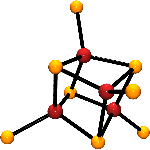 Mo- and W-containing enzymes are relatively common in Nature, being present in a large number of organisms. These enzymes catalyze a variety of redox reactions, including, primarily, oxo-transfer reactions. In the oxo-transfer reaction, a substrate is transformed into its oxidized (e.g., sulfite to sulfate, in sulfite oxidase SO), or into its reduced (DMSO to dimethylsulfide, in DMSO reductase) analogue, by adding or removing an oxygen atom, respectively. Additional reactions, catalyzed by Mo/W enzymes, include oxidation of formate (catalyzed by formate dehydrogenase, FDH), addition of water over the acetylene triple bond (acetylene hydratase, AH), oxidation of C-H bond (xanthine oxidase, XO) and many others. In the majority of the enzymes, those reactions are carried out with the aid of M(IV)/M(VI)O reaction couple.
Mo- and W-containing enzymes are relatively common in Nature, being present in a large number of organisms. These enzymes catalyze a variety of redox reactions, including, primarily, oxo-transfer reactions. In the oxo-transfer reaction, a substrate is transformed into its oxidized (e.g., sulfite to sulfate, in sulfite oxidase SO), or into its reduced (DMSO to dimethylsulfide, in DMSO reductase) analogue, by adding or removing an oxygen atom, respectively. Additional reactions, catalyzed by Mo/W enzymes, include oxidation of formate (catalyzed by formate dehydrogenase, FDH), addition of water over the acetylene triple bond (acetylene hydratase, AH), oxidation of C-H bond (xanthine oxidase, XO) and many others. In the majority of the enzymes, those reactions are carried out with the aid of M(IV)/M(VI)O reaction couple.

Figure 1. Structure of the pyranopterindithiolate cofactor (a); active-site structures of the Mo-dependent SO (b) and W-dependent FDH(c) enzymes.
All Mo/W enzymes include pyranopterindithiolate cofactor(s) (Figure 1a) at the active site. From the structural point of view, pyranopreindithiolate acts as a bidentate ligand, binding to the metal via two sulfur donors. Certain enzymes contain a single pyranopterindithiolate ligand for a single metal center (xanthine oxidase and sulfite oxidase families), while others display two such ligands at a mononuclear active site (Figure 1b and 1c). In our approach to models of the enzyme active site, we employ a dithiolene (Fig. 2) ligand, which mimicks accurately the binding of the pyranopreindithiolate to the metal. We synthesized a variety of Mo and W complexes, incorporating one or two dithiolene ligands. Those species serve as structural and functional models of oxo-transfer enzymes, transferring an oxo atom from or to the substrate, therefore enabling an insight into the enzyme mechanism.

Figure 2. Analogue reaction system of Selenate Reductase, based on the molybdenum and tungsten bis(dithiolene) complexes.

